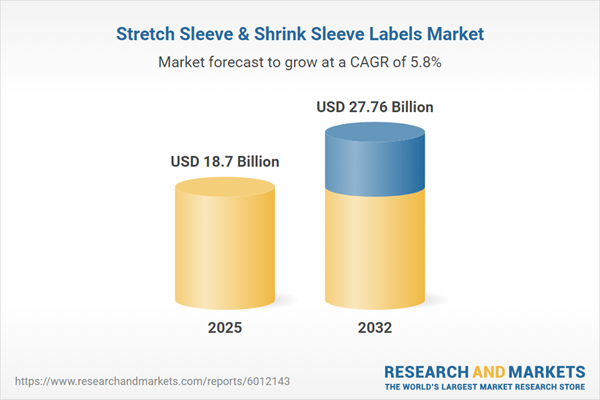Speak directly to the analyst to clarify any post sales queries you may have.
The stretch sleeve & shrink sleeve labels market is rapidly adapting to heightened sustainability demands and evolving regulations. Senior decision-makers must realign labeling strategies to ensure compliance, continuity, and operational agility in a complex, regulated environment.
Market Snapshot: Stretch Sleeve & Shrink Sleeve Labels Market
The stretch sleeve & shrink sleeve labels market is demonstrating robust growth, driven by continued changes to regulatory frameworks and rising expectations for sustainable packaging. Companies across consumer goods, pharmaceuticals, and food and beverage sectors are upgrading their labeling systems to enhance compliance and respond proactively to industry shifts. Material advancements and improvements in application methods accelerate product launches, help organizations adjust to dynamic standards, and reinforce supply chain efficiency. As these trends unfold, companies rely on branding speed and operational flexibility to remain competitive and meet distribution requirements.
Scope & Segmentation
- Packaging Types: Both stretch sleeve labels and shrink sleeve labels ensure full 360-degree coverage for cylindrical and irregularly shaped containers, allowing tailored branding strategies and custom packaging design.
- Printing Technologies: Digital printing helps companies accelerate time-to-market with rapid design changes, while gravure and flexographic techniques deliver consistent results across large or varied production runs.
- Applications: Label solutions are applied across bottles, jars, cans, and other rigid packaging to secure product integrity during transport, storage, and retail movement.
- End-Use Industries: These labeling technologies are preferred for their reliability and compliance by cosmetics, personal care, food and beverage, pharmaceutical, and household product manufacturers.
- Regional Coverage: Custom approaches exist for regions including the Americas, Europe, Middle East & Africa, and Asia-Pacific, each reflecting unique sustainability goals, materials selection, and regulatory requirements.
- Industry Leaders: Companies such as CCL Industries Inc., Multi-Color Corporation, Avery Dennison Corporation, and Constantia Flexibles Group GmbH are recognized for advancing labeling technology and setting best practices within the sector.
Key Takeaways for Decision Makers
- Adoption of modern stretch sleeve & shrink sleeve labeling enables businesses to adjust quickly as regional compliance standards are revised, fostering adaptable market entry strategies.
- Enhanced substrates and advanced print processes improve brand presence and product identification, sustaining consumer trust throughout logistics and retail transitions.
- Switching to mono-materials and incorporating recycled content streamlines the recycling process for used labels, supporting supply chain sustainability goals and regulatory compliance.
- Regional priorities affect labeling investments: in North America, focus is placed on recyclability; in Europe, comprehensive regulatory alignment is prioritized; and Asia-Pacific markets are increasingly choosing digital innovations to increase efficiency and support sector growth.
- Effective collaboration among converters, suppliers, and technology partners is essential to implement emerging solutions, maintain operational agility, and address compliance or supply chain disruptions.
Tariff Impact and Supply Chain Strategy
Recent U.S. tariff changes have prompted companies in the stretch sleeve & shrink sleeve labels industry to revisit supply chain strategies. By expanding domestic production, diversifying supplier bases, and leveraging automation, businesses reduce vulnerability to external disruptions and control operational costs. This approach helps ensure reliable delivery and stable market performance as global trade conditions evolve.
Methodology & Data Sources
This report is grounded in interviews with senior supply chain professionals, detailed evaluations of international regulations, patent disclosure analysis, and assessments of global trade data. All sources are cross-referenced to inform strategic recommendations tailored to executive needs.
Why This Report Matters
- Equips leaders to anticipate regulatory changes and align future labeling strategies for sustained compliance and entry into emerging markets.
- Provides decision support for targeted technology investment, empowering organizations to maximize growth across diverse regions and end-use sectors.
- Offers guidance to enhance risk management and organizational responsiveness to regulatory complexity and supply chain pressures.
Conclusion
This analysis gives senior executives a framework to navigate compliance challenges and drive innovation in the stretch sleeve & shrink sleeve labels market, enabling more informed, resilient operational decisions.
Additional Product Information:
- Purchase of this report includes 1 year online access with quarterly updates.
- This report can be updated on request. Please contact our Customer Experience team using the Ask a Question widget on our website.
Table of Contents
3. Executive Summary
4. Market Overview
7. Cumulative Impact of Artificial Intelligence 2025
Companies Mentioned
The companies profiled in this Stretch Sleeve & Shrink Sleeve Labels market report include:- CCL Industries Inc.
- Multi-Color Corporation
- Avery Dennison Corporation
- Constantia Flexibles Group GmbH
- Huhtamäki Oyj
- UFlex Limited
- Coveris Holdings S.A.
- Sleever International S.A.
- Refine Packaging Solutions, Inc.
- Muthmann GmbH & Co. KG
Table Information
| Report Attribute | Details |
|---|---|
| No. of Pages | 188 |
| Published | November 2025 |
| Forecast Period | 2025 - 2032 |
| Estimated Market Value ( USD | $ 18.7 Billion |
| Forecasted Market Value ( USD | $ 27.76 Billion |
| Compound Annual Growth Rate | 5.7% |
| Regions Covered | Global |
| No. of Companies Mentioned | 11 |









